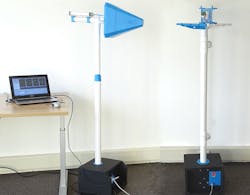System Analyzes Antennas Without Anechoic Chamber
This file type includes high-resolution graphics and schematics when applicable.
Radiation patterns describe the coverage possible with a particular antenna and its associated wireless circuitry, but generating such patterns can be difficult. They are typically generated by a test signal generator, receiver, broadband receive antenna, and many necessary test accessories such as a turntable to rotate a device under test (DUT) while testing. Another relatively common and not-so-inexpensive test-system “accessory” is an anechoic chamber. It prevents interference from radio sources that might be present in the frequency band of interest.
Fortunately, the RMS-0740 MegiQ Radiation Measurement System from MegiQ BV provides everything needed for making three-axis radiation pattern measurements—except the anechoic chamber. It is designed to work without the chamber, delivering accurate radiation-pattern measurements from 0.7 to 4.0 GHz in a moderate-sized room, for hands-on analysis of wireless designs with their integrated antennas.
While antenna patterns are often associated with the radiated electromagnetic (EM) energy from a transmitting antenna, the patterns apply to the performance characteristics of an antenna in receive mode as well. The RMS-0740 measurement system (see figure) is ready to perform radiation-pattern measurements on active DUTs with transmitters, but can also be equipped with an optional signal generator (or configured with a user’s own signal generator) to analyze passive wireless DUTs operating in receive mode.
Sum of its Parts
The radiation-pattern measurement system consists of a dual-channel receiver (with option for a signal generator), dual polarization antenna, stepper-motor-driven turntable for mounting an antenna under test, software, and interconnecting power and control cables, including a Universal Serial Bus (USB) cable for connection to a personal computer (PC). The system rotates a DUT on the turntable and makes three-axis radiation pattern measurements using one turn of the turntable per axis. When necessary, the turntable can be rotated manually, without using the stepper motor.
The MegiQ Radiation Measurement System performs three-axis antenna radiation-pattern measurements from 700 MHz to 4 GHz without need of an anechoic chamber.
The test system features an antenna designed for minimum reflections in compact test areas. Ready for use without calibration, the system is designed for accurate results in moderate test spaces, such as only 4 × 4 × 3 m. It can function in even smaller test spaces, although careful positioning of some absorbing materials may be required to minimize reflections. The test system can measure multiple frequencies at the same time and, with its optional test signal source, will generate horizontal and/or vertical test signals for evaluating a DUT in receive mode.
The height of the system’s measurement antenna can be set from 100 to 170 cm; the measurement antenna and receiver are designed for measurement distances of 0.8 to 3.0 m from a DUT. The receiver performs simultaneous measurements of horizontal and vertical polarization along with harmonic radiation, with minimum measurement step size of 2 deg. A narrow measurement antenna beamwidth is teamed with a narrow test-receiver measurement bandwidth for effective use in a non-shielded, non-anechoic-chamber test environment.
The system can be supplied with a standard-sized, 28- × 28-cm turntable that holds DUTs as large as 7.5 kg, or an optional, 100- × 50-cm, heavy-duty turntable that accommodates DUTs weighing up to 30 kg. The stepper motor spins the turntables at 30 s per rotation during radiation-pattern measurements, although the turntables can also be rotated manually as needed for special radiation-pattern measurements.
Enhanced with Software
The measurement software supplied with the test system simplifies the measurement setup, offering functions for rotational control of the turntable, data storage and processing, graphing, and report generation. It provides three-dimensional (3D) representations of test results, processing data collected by the test antenna and receiver by measuring the radiation patterns in the x, y, and z axes of a DUT mounted on the rotating turntable.
The software is able to produce standard radiation patterns and calculate statistics related to the performance of the DUT, such as minimum, maximum, and average values, total radiated power (TRP), effective radiated power (ERP, in dBm), antenna gain (in dBi), antenna efficiency (in percent), field strength (in dBµV/m), and directivity (in dB). Each measurement point can contain a sweep of multiple frequencies, which makes it possible to measure multiple radiation patterns during a single rotation sequence.
Radiation-pattern measurements often require the assistance of a shielded environment, such as an anechoic chamber or a Faraday cage, which can represent a considerable investment. When the space and funds are short, but the need for radiation pattern measurements is quite real, the compact RMS-0740 MegiQ Radiation Measurement System provides accuracy approaching that of much larger systems and test chambers. On top of that, it covers many of the commonly used wireless frequency bands.
MegiQ BV, Weegschaalstraat 3, 5632CW Eindhoven, The Netherlands; +31-40-2911479.



